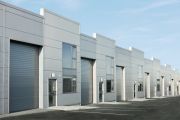
How a farmer’s house became an architectural gem
It is challenging for an architect to rework an award-winning project, particularly when it also happens to have been their home for 17 years.
However, for architect William Smart, director of Smart Design Studio, his former abode and office at 632 Bourke Street, in Sydney’s Surry Hills, is a major triumph.

Built in the 1890s as a combined butcher and greengrocer store, complete with rear stables, the distinctive sandstone buildings and city fringe landmark were initially home to Jacques Foveaux, a farmer in the local area.
“The brief from our clients – a couple of empty nesters whose children spend time there occasionally – was to retain all that worked and update areas that needed to be modified,” says Smart.
Accordingly, he left the basement and first-floor studio relatively untouched – except for providing more thermally efficient glass for the large windows and providing a new roof, made from corrugated steel.
The ground floor area was more than sufficient. However, on the first floor, where there were open-plan offices, there are now two separate apartments, each of about 70 square metres.
What were the rear stables – used by Smart’s former office to conceive new housing schemes – is now a self-contained, two-level apartment, with living areas at ground level and bedrooms above that are ideal for separate tenancy. The owners’ adult children often use the apartments, but they can also be rented when not in use.
Given the quality of the original fit-out, Smart was keen to replace features when needed, but to leave most of the “bones”, including the owner’s penthouse apartment, intact. The built-in bookshelves in the open-plan living area, for example, were slightly modified, as was the main joinery that forms the backdrop to the kitchen.
“Some of the kitchen appliances, such as the fridge, were replaced and concealed behind the new joinery wall,” Smart says. “But we’ve used the same polyurethane finish that we used years ago.” He also retained the distinctive stainless-steel island bench.
Smart and his team were responsible for many of the new fixtures and fittings, including LED lighting and a coffee table that conceals a television when not in use.
When Smart was designing his former apartment, he was inspired by some post-war case study houses found in Palm Springs, in the US. Here, the ceiling of the penthouse features an aluminium profile encasing a cement ceiling. As with the case studies, the eaves extend beyond the glass walls to create a Japanese lantern-style effect.

The two apartments on the first level, previously used for offices, are new – complete with oak panels in passages and oak joinery in the bedrooms.
As with all of Smart’s designs, the devil is in the detail, with built-in oak and Corian bookshelves in the living areas, built-in desks and sculptural timber-lined nooks to display objects and artefacts.
As with a number of William Smart Designs, the island benches in the kitchens of the two apartments appear to be chiselled from one piece of stone. The same level of detail has been applied to the bathrooms, where the floors and walls are lined in terrazzo.
While the rear apartment benefits from generous louvred-glass windows and a view over the neighbourhood, the front apartment is framed by the building’s original French-style doors that lead to a wrought-iron balustrade on the front terrace.
While most architects come to a new commission completely afresh, in this case, Smart knew every square centimetre of the building.
“Even with the new work, there’s still clearly the original intention,” he says. “However, you need to move with the times and consider what is appropriate for both then and now. Certain things go in and out of fashion, but tastes evolve that respond to a particular moment in time.”











